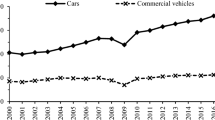Abstract
Critical metals are used increasingly in vehicle manufacturing. For more sustainable use of these metals, it is important to understand their distribution in vehicles. In this paper, we present a comparative study examining the distribution of critical metals in conventional passenger vehicles. We identified two existing approaches to estimate the amounts of critical metals used in one passenger vehicle: input-driven and output-driven approach, and compared the results of 25 metals among five studies. In general, the results were found to be scattered. Cu, Mn, Sr and Sb were found with the highest median masses per vehicle. The median masses of eight metals (Nb, Zr, Co, La, Mo, Nd, Ce, and Ag in descending order) were around or below 10 g per vehicle and those of 13 metals (Pd, Ta, Pr, Ga, Sm, Y, W, Au, Gd, Dy, In, Pt, and Tb in descending order) were below 1 g per vehicle. Top three subsystems and parts containing the largest mass of critical metals in sum were presented. Our research provides a consolidated summary of existing information on the critical metal distribution in conventional passenger vehicles and suggests improvements for future studies on this topic.

Similar content being viewed by others
References
Du X, Graedel TE (2013) Uncovering the end uses of the rare earth elements. Sci Total Environ 461–462:781–784
Du X, Graedel TE (2011) Global rare earth in-use stocks in NdFeB permanent magnets. J Ind Ecol 15:836–843
Du X, Graedel TE (2011) Global in-use stocks of the rare earth elements: a first estimate. Environ Sci Technol 45:4096–4101
Yoshimura A, Daigo I, Matsuno Y (2013) Global substance flow analysis of indium. Mater Trans 54:102–109
European Commission (2010) Critical raw materials for the EU
DOE (2011) US Department of Energy Critical Materials Strategy
Erdmann L, Graedel TE (2011) Criticality of non-fuel minerals: a review of major approaches and analyses. Environ Sci Technol 45:7620–7630
Wäger P, Lang D, Wittmer D, Bleischwitz R, Hageluken C (2012) Towards a more sustainable use of scarce metals: a review of intervention options along the metals life cycle. GAIA 21:300–309
Sakai S, Yoshida H, Hiratsuka J, Vandecasteele C, Kohlmeyer R, Rotter V et al (2013) An international comparative study of end-of-life vehicle (ELV) recycling systems. J Materl Cycles Waste Manag 16(1):1–20
Ministry of Environment Japan (2010) Report on 2010 Survey to Identify the Characteristics of Automotive Shredder Residue. Ministry of the Environment, Japan
Ministry of Environment Japan (2009) Report on FY2009 Survey to Promote Streamlining of End-of-Life Vehicle Recycling. Ministry of the Environment, Japan
Cullbrand K, Magnusson O (2012) The use of potentially critical materials in passenger cars. Chalmers University of Technology, Gothenburg
Alonso E, Wallington T, Sherman A, Everson M, Field F, Roth R et al (2012) An assessment of the rare earth element content of conventional and electric vehicles. SAE Int J Mater Manuf 5:473–477
Widmer R, Du X, Restrepo E, Wäger P (2014) Scarce Metals in Conventional Passenger Vehicles and End-of-Life Vehicle Shredder Output (in review)
Commission European (2014) “Report on critical raw materials for the EU “ European Commission. Belgium, Brussels, p 2014
Deetman S, Kleijn R, Bringezu S, Schütz H, Pauliuk S (2014) “D6.1 Indicators for critical materials,” ed
Müller E, Hilty LM, Widmer R, Schluep M, Faulstich M (2014) Modeling metal stocks and flows-a review of dynamic material flow analysis methods. Environ Sci Technol 48(4):2102–2113
Mathys R, Dittmar J, Johnson CA, Krähenbühl P (2007) Antimony in Switzerland: a substance flow analysis: federal office for the environment FOEN
Claeys C, Simoen E (2011) Germanium-based technologies: from materials to devices. Elsevier
Kavlak G, Graedel TE (2013) Global anthropogenic tellurium cycles for 1940–2010. Resour Conserv Recycl 76:21–26
Duclos SJ, Otto JP, Konitzer DG (2010) Design in an era of constrained resources. Mech eng 132:36–40
Acknowledgments
We thank Michael Gasser from Empa for the help with drawing the figures and the Swiss Federal Office of the Environment (FOEN) for their financial support.
Author information
Authors and Affiliations
Corresponding author
Electronic supplementary material
Below is the link to the electronic supplementary material.
Rights and permissions
About this article
Cite this article
Du, X., Restrepo, E., Widmer, R. et al. Quantifying the distribution of critical metals in conventional passenger vehicles using input-driven and output-driven approaches: a comparative study. J Mater Cycles Waste Manag 17, 218–228 (2015). https://doi.org/10.1007/s10163-015-0353-3
Received:
Accepted:
Published:
Issue Date:
DOI: https://doi.org/10.1007/s10163-015-0353-3




